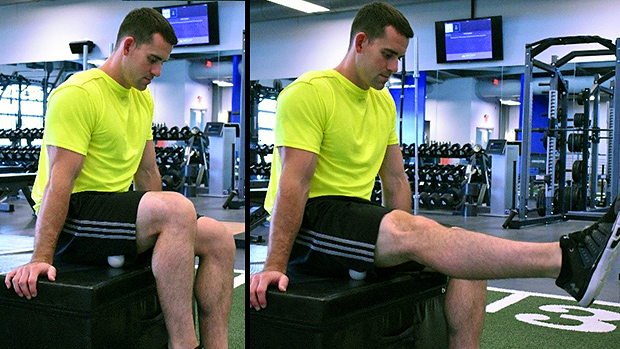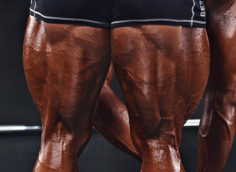There's not a movement you do that doesn't involve your lower back in some way. So if you've managed to tweak it recently, fear not. Use this five-step process to get your back strong, pain-free, and ready to lift.
Are you currently deadlifting? If not, and you're able to, then start. The deadlift strengthens every muscle in your body, including your lower back. It's the premier hip hinge movement and should be featured in your program.
Vary your deadlift. Use a straight bar AND a trap bar. If you're using a straight bar every time, there's a good chance you're going to burn out your spinal erectors. The trap bar is a great way to train your hip hinge, and you get the added bonus of placing less stress on your lower back.

Think about the hip hinge movement pattern when you're deadlifting. It doesn't matter which tool you use (straight or trap bar) as long as you're getting stronger at the pattern.
In addition to your main lifts, play around with accessory movements such as deficit deadlifts, deadlifts from blocks, as well as sweeping deadlifts. Expose your body to a variety of different stimuli to keep the move interesting and prevent plateaus.
Include lots of glute and hamstring exercises. Strong glutes and hams will help you when trying to pull heavy weight from the floor. The more your hamstrings and glutes activate during the deadlift, the safer your lower back will be. Add glute bridges, GHDs, and good mornings to complement your heavier lifts.

Now that we've established that you need to deadlift and hit some accessory work for your hamstrings and glutes, let's take a look at the core movements you're doing.
There's this meathead belief that all you need to do is squat and deadlift to get a strong core. Although we'd never disagree that squatting and deadlifting will give you a strong core, hitting some isolated core movements is a great way to help protect your lower back.
The thing is, there's a right and wrong way of going about it. Doing crunches to infinity won't cut it. And if you're spastically yanking on the back of your head you'll just add a neck injury to complement your shitty core development.
The core exercises you should be doing are classified as flexion, anti-flexion, lateral flexion, lateral anti-flexion, extension, anti-extension, rotation, and anti-rotation exercises. Examples:
- Flexion – V-Up
- Anti-Flexion – Superman Hold
- Lateral Flexion – Side Plank Hip Dip
- Anti-Lateral Flexion – Suitcase Carry
- Extension – Reverse Hyper
- Anti-Extension – Plank
- Rotation – Banded Twist
- Anti-Rotation – Banded Press Out
Pick the ones that will give you the most bang for your buck. My recommendation? Go with anti-movements. Being able to resist against flexion, lateral flexion, extension, and rotation will greatly improve your core stability. In addition to the anti-movements, add some rotational movements. This will ensure you're mobile as well as stable.
Knowing how to lift will be the difference between gaining herculean strength or ending up in a ton of pain with no gain. So let's start with the deadlift. When you deadlift, setup like this:

- Feet are hip-width apart with the weight in your heels.
- Palms are just outside your legs.
- The bar is right next to your shins.
- Your chest is up and your back is strong and flat.
- Your chin is tucked and your head is in neutral alignment.
Once you know that your setup is good, it's time to grab greatness by the gonads. When you go to pull the deadlift do the following:
- Take a deep breath in and brace your core.
- Drive your knees out and your hips forward as you pull up on the bar.
- Squeeze your shoulder blades together maintaining a strong, flat back.
- Keep your head neutral as you complete the lift.


In addition to the deadlift, make sure you do core exercises with intention. Below are some of the common core exercise blunders and their fixes.
Plank
The first thing you want to do is make sure your hips are level. Increasing the time on your plank by raising or sagging your hips defeats the purpose.


Do NOT try to set a world record plank hold. Instead, be more concerned with the intensity of the contraction rather than the duration. Focus on pulling your abdomen to your spine so hard that your body begins to shake.

A plank that gives you solid core benefits doesn't really need to last longer than 15 seconds if you're contracting as strongly as possible.
Banded Twist (Cable Chop)
Make sure you're performing a large movement through the torso. There should be relatively little movement through the hips. Try to pull your abdomen towards your spine as you begin to twist. Also, be sure your arms are straight since bending the elbows cheats the movement.


Can you lean over and touch your toes without bending your knees? If not, you've got some work to do.
Being inflexible isn't a sign of strength; it's a signal that you'll have an injury in your future. People who are rigid do not bend; they break. Most of us are spending the majority of our time on our asses, so we're bound to get tight. We need to address our lack of mobility.
Some of the common culprits for lower back pain include tight hip flexors, tight hamstrings, and a weak core. All three cause an anterior pelvic tilt, which means your pelvis rotates forward and places more stress on your lower back.
In order to relieve pressure on your back, do soft tissue work, muscle activation for your core, and stretching. We'll get into all three.
Releasing The Hip Flexor

Lie flat on the ground and place a softball under your hip bone. Draw small circles with your hip over the softball and pause over the areas that are the most sensitive.
Releasing The Hamstrings

Sit on a hard, flat surface and place a lacrosse ball under your hamstring. Roll around on the ball until you find a tender area. Extend and flex your knee once you find an area of tension.
Releasing the Spinal Erectors

Place lacrosse ball into the side of your lower back and lean against a wall. Press from the outside of the lower back inwards to release the spinal erectors. Breathe out as you apply pressure.
Before you get your swole on, take a little time to get the glutes firing and your core bracing. This is helpful if you'd like to not ruin the next few months of your life with a low back injury.
Your glutes will assist you with your deadlift instead of just relying on your low back. Muscle activation for your core will help restore balance to the body before you go heavy. Here are some good pre-lift muscle activation exercises.
Exercise Ball Hamstring Curl


Lie on your back and place your feet on an exercise ball. Lift your hips and bend your knees, bringing your heels to your butt.
Dead Bug

Lie on your back with your arms extended above you and your hips and knees bent at a 90-degree angle. Extend one leg and the opposite arm at the same time while pressing your lower back into the ground.
Bird-Dog

Start in a tabletop position with your wrists stacked beneath your shoulders. Slowly extend your opposite arm and opposite leg in front of you while bracing your core.
Stretch after training and take it seriously. Your post-workout stretch isn't the time to chat. After you just spanked the weights during your monster workout it's time to give some love to your low back.
Side Lying Twist

Pull one knee into your chest and gently pull it across your body. Keep both shoulders on the ground as you look in the opposite direction of the leg you're stretching.
Sit With Shoulder Look

Sit on the ground with your knees slightly bent and legs open. Lean forward as you press one knee away from your body. As you exhale, turn and look over the same shoulder as the knee you're pressing.
Downward Dog With Reach

Distribute your weight evenly between your hands and feet. Reach your opposite hand towards your opposite foot. Exhale as you twist your torso and look under the armpit of the hand that's on the ground.




